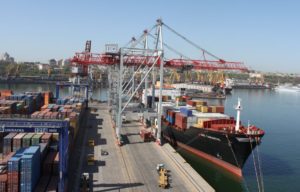
The seaports of Ukraine in 2018 handled over 135 million tonnes of cargo, which is 2.4 million tonnes or 1.8% more than in 2017. According to live information from the Ministry of Infrastructure, posted on its website, exports in ports amounted to 98.9 million tonnes, which is 383,000 tonnes more than last year, imports to 23.78 million tonnes.
In 2018, transshipment of containers in Ukrainian seaports amounted to 10.93 million tonnes (container handling grew by 11%).
Domestic shipments between the seaports of Ukraine amounted to 2.1 million tonnes, which is 14% (260,000 tonnes) more than last year. Dredging works are continuing at nine sites in the seaports, two projects in the ports of Olvia and Kherson have been prepared for concession. The number of ship journeys along the Dnipro River was 16,390, which is 11% more compared to last year. In general, in 2018 about 10 million tonnes of cargo were transported by river.
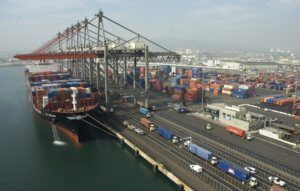
Ukrainian seaports in January-November 2018 handled 121.5 million tonnes of cargo, which is 0.61% more than a year ago.
“It was possible to improve the performance of the previous year due to the increase in cargo volumes of the metallurgical and agrarian industry, as well as containers,” the Ukrainian Sea Ports Authority said on its website.
According to the report, during this period, the seaports accepted and sent 10,600 ships, which are 3,080 ships (2.9%) less than in 2017.
The authority recorded an increase in the volume of metal products – by 11%, to 1.45 million tonnes, as well as agricultural goods, in particular grain (by 0.1%, to 35.9 million tonnes), peas and corn (by 8.4%, up to 717,000 tonnes).
In general, over the period, the transshipment of export cargoes in Ukrainian seaports amounted to 88.8 million tonnes, which is 1.4% less compared to the same period in 2017. At the same time, there was an increase in exports of ferrous metals, to 13.6 million tonnes (an increase of 9%); including 8 million tonnes of rolled metal products (a decrease of 0.9%) and 2.7 million tonnes of pig iron (an increase of 36.55%).
Handling of imported cargo increased 18.13%, to 21.5 million tonnes. Imports of coke significantly increased (4.7 times, to 408,900 tonnes), chemical and mineral fertilizers (2.7 times to 313,200 tonnes). Almost one third of all imports entering Ukraine through sea ports is ore, which increased by 17.7% compared with January-November 2017, to 6.9 million tonnes.
Cargo turnover of transit cargo amounted to 9.2 million tonnes, 15.2% less than a year earlier.
In addition, from January to November 2018, more than 500,000 passengers were transported.
In January-November 2018, 15,600 passages of ships were carried out along the Dnipro River, which were 1,324 or 8.5% more than a year earlier.
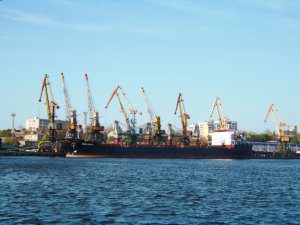
Chornomorsk seaport (Odesa region) in January-July 2018 increased cargo handling by 31.2% compared to January-July 2017, to 11.953 million tonnes.
According to the Ukrainian Sea Ports Authority, for the seven months of 2018 the enterprise increased transshipment of exported cargo by 15.87%, to 8.87 million tonnes, imported goods by 2.43 times, to 2.438 million tonnes. Transshipment of transit cargo increased by 37.7%, to 618,330 tonnes, while the port handled 22,460 tonnes of cabotage cargo.
Transshipment of liquid cargo decreased by 7.93%, to 933,660 tonnes, dry bulk cargo increased by 20.69%, to 7.99 million tonnes, that of non-bulk goods doubled, to 3.03 million tonnes. Transshipment of containers amounted to 98,616 TEU.
Chornomorsk port is a universal international port, one of the largest on the Black Sea. The enterprise has specialized terminals and complexes, which allow overloading a wide range of goods: liquid, bulk, general. Its 29 berths are capable of receiving ships with a carrying capacity of up to 100,000 tonnes. The annual designed capacity of the port is more than 30 million tonnes.

The Chornomorsk maritime merchandise port (Odesa region) in January-May 2018 increased cargo handling by 32.51% year-over-year, to 8.735 million tonnes.
According to data from the Ukrainian Sea Port Authority, over the period the port boosted transshipment of export cargo by 15.65%, to 6.42 million tonnes, while handling of imported cargo grew 2.45-fold, to 1.867 million tonnes. Transit cargo transshipment rose by 59.3%, to 442,930 tonnes. The port handled 5,860 tonnes of intercoastal cargo.
Transshipment of bulk cargo fell by 20.26%, to 628,950 tonnes, packaged cargo transshipment soared by 97.59%, to 2.21 million tonnes and dry cargo – grew by 25.86%, to 5.897 million tonnes.
Chornomorsk port is a universal international port, one of the largest on the Black Sea. The enterprise has specialized terminals and systems, which allow overloading a wide range of goods: liquid, bulk, general. Its 29 berths are capable of receiving ships with a carrying capacity of up to 100,000 tonnes. The annual designed capacity of the port is more than 30 million tonnes.
The port’s capacity of container handling is 1.15 million TEU. Since 2007 the port has been capable of providing the simultaneous accepting of three ocean-going container ships with a capacity of more than 5,000 TEU and a length of up to 300 meters.
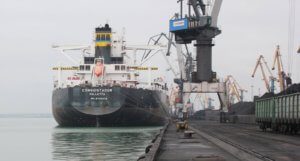
Freight handling at Ukrainian seaports in January-May 2018 totaled 54.3 million tonnes, which is 2.13% less than a year ago, according to data from the Ukrainian Sea Port Authority.
According to its data, the volume of transshipment of imported cargo increased by 16% and amounted to 9.05 million tonnes.
The volume of transshipment of exported cargo decreased 7.35%, to 39.71 million tonnes. Handling of transit freights rose by 11.2%, to 4.824 million tonnes and handling of coastal freight rose by 49.3%, to 714,730 tonnes.
Transshipment of liquid freight fell by 9.78%, to 4.3 million tonnes, that for bulk freight – by 8.35%, to 36.95 million tonnes and for packaged cargo grew by 25.5%, to 13.05 million tonnes.
Container flow at Ukrainian seaports in January-May 2018 grew by 36.9%, to 325,035 TEU, and processing of containers in weight rose by 34.4%, to 4.274 million tonnes.
In general, the seaports of Ukraine processed 4,855 vessels in January-May 2018, including 1,026 in May.
The decline in cargo turnover is attributed to the reduction in grain handling by 4.9%, caused by unfavorable prices for it on the global market in this period, as well as a 15.5% decrease in ore turnover due to a decrease in ore mining by ore-dressing plants, the authority said.
“The upward pace of imports continue to be recorded for the following cargo: ore (17.8% up), transshipment of which amounted to 3 million tonnes and coal – 2.4 million tons (4.1% up), the largest increase in imports showed ferrous metals (18% up) – 6.8 million tonnes, including 4.1 million tonnes of rolled metal (4.1% up) and 1.3 million tonnes of pig iron (85.5% up),” the authority said.
During the reporting period, 3,130 ship journeys were made on the Dnipro River, which is 287 journeys, or 8.7% more than a year earlier.
A total of 316,800 tonnes of metal products were transported along the Dnipro (6.2% growth compared with the corresponding period of 2017), as well as 683,600 tonnes of grains (a decrease of 7%), 17,300 tonnes of oil products (an increase of 5.2%) and 902,000 tonnes of construction materials (an increase of 24.3%) and other goods.
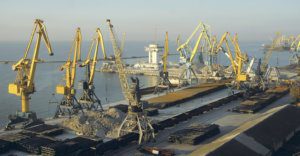
Mariupol seaport (Donetsk region) in January-March 2018 increased cargo handling by 10.5%, year-over-year, to 1.333 million tonnes.
In the first three months of 2018, the port increased transshipment of exported cargo by 5.8%, to 1.26 million tonnes, imported freight by 4.3 times, to 56,000 tonnes, cabotage cargo by 6.5 times, to 16,300 tonnes, the Ukrainian Sea Ports Authority said.
Yet, the port did not handle transit goods.
According to the types of cargo, the port did not handle liquid cargo, while dry bulk handling rose by 1.2%, to 239,000 tonnes, that of non-bulk goods increased by 17.8%, to 1.094 million tonnes.
Mariupol seaport is one of the largest ports of Ukraine. Its capacity allows handling more than 17 million tonnes of cargo per year. The port is open all year round for ships with a length of up to 240 meters and a draft of up to 8 meters. Its territory is 73.2 hectares, the length of the berthing line is 4.2 km.